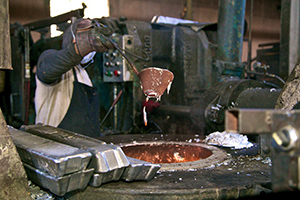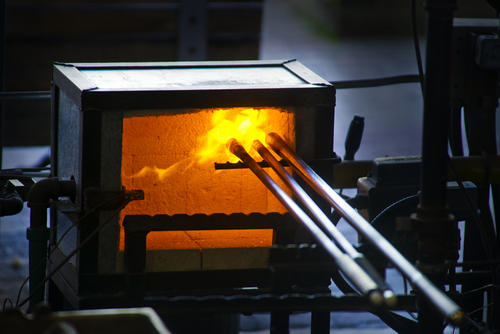 The zinc die casting process is characterized by pressuring metal in molten form into a die cavity. Also known as a mold cavity, it is made with hardened steel dies that are machined into the near net shape or net shape of zinc castings or die cast parts. The die casting process lets products be made with a high degree of precision as well as reliability. It can also generate fine details like textured surfaces without necessitating further processing. If required, further surface finishing such as powder coating and E-coat can also be applied to improve the parts’ finish and meet customer requirements. As said, zinc castings can also be used raw.
The zinc die casting process is characterized by pressuring metal in molten form into a die cavity. Also known as a mold cavity, it is made with hardened steel dies that are machined into the near net shape or net shape of zinc castings or die cast parts. The die casting process lets products be made with a high degree of precision as well as reliability. It can also generate fine details like textured surfaces without necessitating further processing. If required, further surface finishing such as powder coating and E-coat can also be applied to improve the parts’ finish and meet customer requirements. As said, zinc castings can also be used raw.
Owing to its relatively low melting point, zinc was amongst the first alloys ever to be subjected to die casting. Nowadays, most zinc alloys used in the process are based upon the Zn–Al–Cu–Mg system. They are essentially classified into two – the ZA and ZAMAK alloys. The former alloys essentially contain four percent aluminum, alongside different levels of magnesium as well as other elements (nickel or copper). The latter alloys contain even higher amounts of aluminum, alongside different levels of both magnesium as well as copper.
These zinc alloys are the easiest to die cast. The finished output of the process is called a “casting”. The steel dies that are capable of making tens of thousands of parts in quick succession have to be made in two sections at the least to allow them to be removed. In a nutshell, the die casting process works as follows.
The parts are mounted firmly in the machine and arranged in such a way that one die half is fixed and the other is movable. To start the die casting cycle, these die halves are clamped by a die casting equipment unit. The molten zinc is then injected into the die cavity and is hardened quickly. The die half is then opened and the casting or part is ejected. The molds can either be simple or intricate, with moveable slides, cores, or other parts, depending upon the casting’s complexity.
Salient Features of Zinc Die Casting
To date, the zinc die casting cycle has been the quickest one to produce accurate components. This is in contrast to the sand casting process, which necessitates fresh sand molds for every casting.
The characteristics of zinc alloys include high strength as well as hardness, high thermal conductivity, excellent electrical conductivity, high dimensional precision and stability, exceptional thin wall capability, outstanding resistance to corrosion, and high-quality finishing. Zinc is also a highly recyclable material, which is one of the reasons why foundries prefer it for many manufacturing applications.
The high strength, as well as hardness of zinc, lends itself to several applications. It is the perfect substitute for machined, stamped, pressed, as well as fabricated parts. The intricate and net-shaped housings, with accurate thin walls, provide excellent electrical performance, as well as shielding properties. Zinc’s castability, its structural integrity, and wear resistance, make it ideal for the production of multi-faceted and highly intricate shapes used in automotive safety as well as the electronics segment.
Zinc is one of the popular metals used to make automotive parts, although zinc parts are also used in the building and industrial sectors albeit to a lesser degree in comparison.
Zinc and aluminum castings make up the majority of the automobile parts. It is also one of the most significant metals in the automobile segment, especially for parts such as door lock housing,  pulleys, pawls, and retractor gears in a seat belt system. By using zinc as well as the alloys of it, it is perfectly possible to arrive at a strength, ductility, as well as malleability which will not be likely to achieve using other materials.
pulleys, pawls, and retractor gears in a seat belt system. By using zinc as well as the alloys of it, it is perfectly possible to arrive at a strength, ductility, as well as malleability which will not be likely to achieve using other materials.
Common Applications of Zinc
Zinc’s most common application is seen in the automobile segment; by using it and its alloys, it is possible to create parts that are capable of reaching a high aesthetic quality, with narrow and strict tolerances for the shapes morphology. The zinc alloy is used also for plating purposes owing to its several benefits, like enhancing the existing anti-corrosion properties of zinc.
Selecting the right alloy for die casting is a challenging task – die casters have to analyze the application, material’s density, tensile and yield strengths, the melting temperature, as well as elasticity to get better output with all of its aesthetical and functional requirements.
Pacific Die Casting is one of the best die casters in North America. We have a proven track record of being a top die-cast component manufacturer, including for aluminum, brass, and zinc die cast parts. The physical properties of zinc also make it a worthy alloy for our expert engineers. We have a rich clientele coming from various industries, including everything from lighting and automobile to the rather niche home appliance segment.
Run in Pacific Die Casting’s high production hot chamber die casting machines. Zinc is the easiest alloy to cast, it offers:
- High ductility
- High impact strength
- Easily plated
- Economical for small parts
- Low melting point
- Long die life
Are you unsure which metal to cast your parts? Want a Quote on a zinc part?
